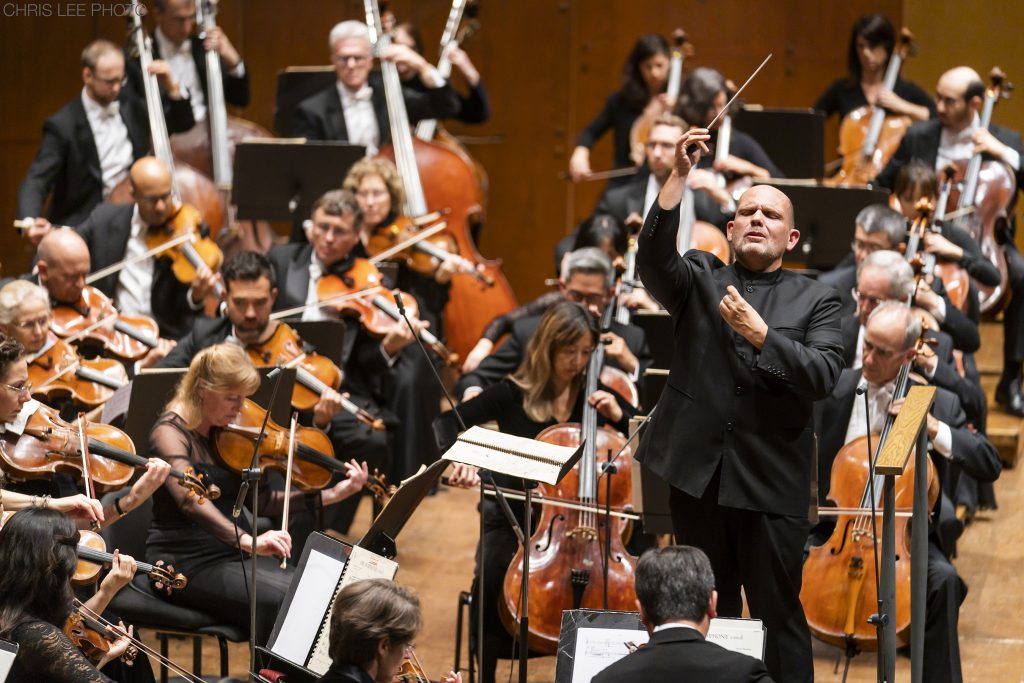Musical worlds cohere with rewarding Bruckner and Tao by van Zweden, Philharmonic

Jaap van Zweden conducted the New York Philharmonic in music of Bruckner and Conrad Tao Thursday night at David Geffen Hall. Photo: Chris Lee
This first season of Jaap van Zweden’s tenure as New York Philharmonic music director promises a lot of new music.
The first two subscription concerts have each begun with world premieres from young American composers. Last week Ashley Fure’s Filament provided the season’s first notes, and Thursday night’s opener for the second series of concerts kicked off with Everything Must Go, by pianist and composer Conrad Tao.
Unlike the standard concert program of fanfare or overture-like music, concerto, then symphony after intermission, van Zweden made a near-seamless whole of the evening by skipping the interval and segueing from Everything Most Go to the feature work, Bruckner’s massive, dark, Symphony No. 8.
This was a simple idea that reaped great rewards. In an obvious but often woefully underappreciated way, this revealed the continuum upon which both Bruckner and Tao are marked—in other words the long span of classical music, connecting two sets of musical ideas that were in sympathy.
Everything Must Go is an overture in disguise. It began with fractured gestures of the Classical and Baroque varieties that build to a mass before gradually dissipating, ablating into whistles, chirps and quiet little squeaks. The sound was familiar from the late 1950-early 1960 avant-garde, and the expressive feeling was of powerful anxieties being squeezed through a too-small tube.
But it delivered. To Tao’s credit, Everything Must Go transparently reflected his stated idea about “the image of a cathedral gaining sentience as it melts.” With the segue to the opening wisps of Bruckner’s Eighth, two eras were connected.
Van Zweden at first took an ultra-Wagnerian approach, an unconvincing interpretation in a piece that came well after Bruckner had shed the cloak of Wagner. Despite it’s considerable duration, Symphony No. 8 is built out of small units of streamlined, fairly discrete, material. Yet van Zweden begin the first movement trying to tease out a through-composed narrative by exaggerating metric modulation and phrasing.
But then the great crisis before the first movement coda arrived, and the bitter, savage playing of the orchestra—especially the low brass, who were stupendous all night—blew away that notion, leaving a proper Bruckner interpretation—that of a composer who built complex and profound objects by laying out and connecting their multifaceted surfaces, piece by piece.
From there, van Zweden’s direction was as masterful as the orchestra’s playing. Bruckner’s music is subjective, not a view of the world around him but the one inside him. There are stories for any listener to find in the music, but they are not linear series of events but journeys of psychological exploration, with beautiful and difficult things to discover.
That was the experience of the bulk of the performance. Playing from the Nowak edition of Bruckner’s revised 1890 score, the orchestra produced the huge, organ-like, Brucknerian sound, full of mass and extending out into twisting and sharp-edged overtones that somehow made David Geffen Hall seem small.
The through-line of tempo and pace were ideal. The Scherzo was exhilarating and rapturous in turn, the Philharmonic athletic and poised. Van Zweden set the Adagio at a perilously slow tempo, even below the feeling of solemnity that Bruckner calls for. Yet each phrase had a pulsing forward motion, the simple rise and fall at the end of the initial theme was like an oar-stroke pushing the vessel out just a bit farther on still waters.
The slow movement made the concert a special experience, as one recalled how Tao’s piece had melted into nothingness, only to rise again as a component of this marvelous slow movement. The conductor and musicians’ attention to the return of the opening phrase in the concluding pages was a wonderful example of musical and expressive understanding; beginning in uncertainty, the movement concluded with assurance and peace.
The Philharmonic played the final movement with a mighty and steely posture, determined and propulsive strides into each future moment. Van Zweden brought out a thrilling quiet, palpable tension at the start of the coda, the orchestra then producing tremendous power and thrills through superb shaping of dynamics at the conclusion.
This program will be repeated 8 p.m. Friday at David Geffen Hall. nyphil.org





